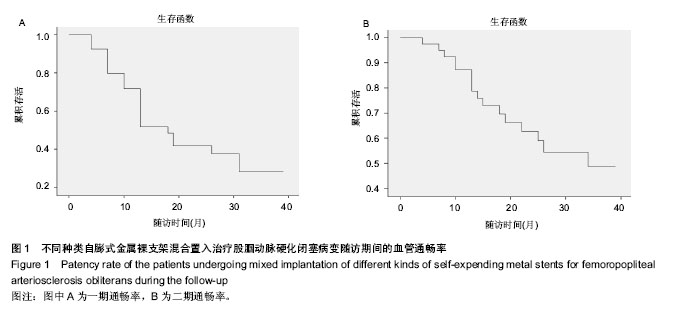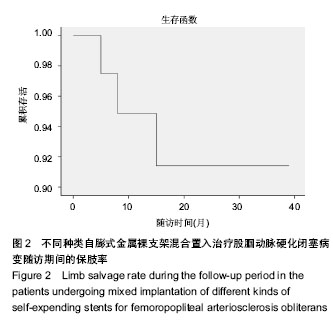| [1] 管强,段红永,梁宁,等.下肢动脉硬化闭塞症介入治疗及并发症分析[J].中华普通外科杂志,2014,29(3):203-206.
[2] Zeller T.Current state of endovascular treatment of femoro-popliteal artery disease.Vasc Med.2007;12(3): 223-234.
[3] Dierk S,Andrej S,Giancarlo B,et al.Tecbniques for peripheral interventions. Munich, Urban & Vogel Gmb H, 2007:28-45.
[4] Norgren L,Hiatt WR,Dormandy JA,et al.Inter-society consensus for the management of peripheral arterial disease. Int Angiol.2007;26:81-157.
[5] Kim SJ,Kim W,Kim JB,et al.Determinants of procedural success and patency following subintimal angioplasty in patients with TASC C and D femoropopliteal arterial disease. Cire J.2010;74:1959-1964.
[6] 袁海,金星,张十一,等.TASC C型和D型主髂动脉闭塞的腔内治疗及评价[J].中华普通外科杂志,2008,23(12):963-965.
[7] 杨牟,李鲁滨,张居文,等.TASCⅡ-C/D型股腘动脉闭塞症的腔内治疗[J].中国普通外科杂志,2011,20(12):1319-1322.
[8] European Stroke Organisation,Tendera M,Aboyans V,et al. ESC Guidelines on the diagnosis and treatment of peripheral artery diseases: Document covering atherosclerotic disease of extracranial carotid and vertebral, mesenteric, renal, upper and lower extremity arteries: the Task Force on the Diagnosis and Treatment of Peripheral Artery Diseases of the European Society of Cardiology (ESC).Eur Heart J. 2011;32(22): 2851-2906.
[9] Schofer J,Schluter M,Gershlick AH,et al.Sirolimus-eluting stents for treatment of patients with long atherosclerotic lesions in small cornary arteries: double-blind,randomized controlled trial(ESIRIUS).Lancet.2003;362:1093-1099.
[10] 罗心平,施海明,朱军,等.不同种类冠状动脉药物洗脱支架混合使用87例临床研究[J].中国介0入心脏病学杂志,2005,13(3): 154-157.
[11] 高晓丽,王东颖,王海斌,等.串联Excel、Partner支架与串联双Excel支架治疗冠脉长病变的对比研究[J].中国心血管病研究, 2013,11(11):852-855.
[12] DeRubertis BG, Faries PL,McKinsey JF,et al. Shifting paradigma in the treatment of low extremity vascular disease. Ann Surg.2007;246(3):415-424.
[13] 刘昌伟.股腘动脉硬化闭塞症治疗方法的合理选择及评价[J].中国实用外科杂志,2008,28(10):842-844.
[14] 温志国,杜丽萍,李文明,等.TASC Ⅱ C/D型下肢动脉硬化闭塞症的腔内治疗[J].中华普通外科杂志,2014,29(1):29-31.
[15] 邢彤,杨宝钟,宋盛晗,等.腔内支架植入治疗TASCⅡ C、D型股腘动脉慢性闭塞病变[J].中华普通外科杂志,2012,27(8):616-618.
[16] 张立魁,吴丹明,周玉斌,等.腔内支架治疗泛大西洋协作组(TASC)Ⅱ C、D级股动脉病变[J].中国微创外科杂志,2012,12(4): 340-343.
[17] 罗小云,张福先,张昌明,等.严重肢体缺血的股胭动脉TASCC/D级病变的腔内治疗[J].中华普通外科杂志,2012,27(11):876-878.
[18] Klikert P,Post PN,Breslau PJ,et al.Saphenous vein versus PTFE for above-knee femoropopliteal bypass, a review of the literature.Eur J Vasc Endovasc Surg.2004;27:357-362.
[19] Adam DJ,Beard JD,Cleveland T,et al. Bypass versus angioplasty in severe ischemia of the leg (BASIL): multicentre,randomised controled trial.Lancet. 2005;366: 1925-1934.
[20] Kudo T,Chandre FA,Ahn SS.The effectiveness of percutaneous transluminal angioplasty for the treatment of critical limb ischemia: a 10-year experience.J Vasc. 2005;42:412-418.
[21] George JC, Rosen ES, Nachtigall J,et al. SUPERA Interwoven Nitinol Stent Outcomes in Above-Knee IntErventions (SAKE) Study.J Vasc Interv Radiol. 2014;25(6): 954-961.
[22] Abizaid A,Popma JJ,Tanajura LF,et al.Clinical and angiographic results of percutaneous coronary revascularization using a trilayer stainless steel-tantalum- stainless steel phosphorylcholine-coated stent: the TriMaxx trial. Catherter Cardiovasc Interv.2007;70(7): 914-919.
[23] Hanawa T.Materials for metallic stents. J Artif Organs.2009: 12(2):73-79.
[24] Taylor RA,Siddiq F,Suri MF,et al. Risk factors for in-stent restenosis after vertebral ostium stenting.J Endovasc Ther. 2008;15(2):203-212.
[25] Early M,Kelly DJ.The role of vessel geometry and material properties on the mechanics of stenting in the coronary and peripheral arteries.Proc Inst Mech Eng H.2010;224(3): 465-476.
[26] 田硕,黄新天,蒋米尔,等.下肢动脉粥样硬化闭塞症腔内治疗后再闭塞的原因分析及应对策略[J].中国血管外科杂志(电子版), 2013,5(2):83-85.
[27] 宋希涛,刘昌伟,曾嵘,等.股腘动脉慢性完全闭塞性病变腔内治疗效果及预后分析[J].中华医学杂志,2014,94(9):641-645.
[28] Ye M,Zhang H,Huang X,et al.Retrograde popliteal approach for challenging occlusions of the femoral-popliteal arteries.J Vasc Surg.2013;58:84-89.
[29] Davies MG,Saad WE,Peden EK,et al.Impact of runoff on superficial femoral artery endoluminal interventions for rest pain and tissue loss.J Vasc Surg.2008;48: 619-625.
[30] Keeling AN,Khalidi K,Leong S,et al.Subintimal angioplasty: predictors of long term success.J Vasc Interv Radiol.2009; 20:1013-1022.
[31] Smolock CJ,A naya-Ayala JE,El-Sayed HF,et al.Clinical efficacy of concomitant tibial interventions associated with superficial femoral artery interventions in critical limb ischemia. J Vasc Surg.2013;57:19-27.
[32] 谷涌泉,张建,齐立行,等.动脉自膨式支架置入治疗下肢缺血[J].中国微创外科杂志,2006,6(11):824-826.
[33] 杨心蕊,陆信武,蒋米尔,等.自彭式裸支架治疗股腘动脉狭窄闭塞性病变的临床评价[J].中华普通外科杂志,2014,29(8):600-602.
[34] 吴田方,代远斌.不同材料周围动脉支架置入治疗动脉硬化闭塞症的研究与进展[J].中国组织工程研究,2012,16(12): 2261-2264.
[35] Bernstein O,Chalmers N.New treatments for infrapopliteal disease:devices,techniques,and outcomes so far.Cardiovasc Intervent Radiol.2012;35(4):715-724.
[36] Cronenwett JL,Wayne Johnston K.Rutherford Vascular Surgery.7th edition,Elsevier Medicine,2010:1366-1367.
[37] Higashiura W,Kubota Y,Sakaguchi S,et al.Prevalence, factors, and clinical impact of self-expending stent fractures following iliac artery stenting.J Vas Surg. 2009;49(3):645-652.
[38] Scheinert D,Scheinert S,Sax J,et al.Prevalence and clinical impact of stent fractures after femoropopliteal stenting. J Am Coll Cardiol.2005;45(2):312-315.
[39] Iida O,Nanto S,Uematsu M,et al.Effect of exercise on frequency of stent fracture in the superficial femoral artery.Am J Cardiol.2006;98(2):272-274.
[40] Babalik E,Gülbaran M,Gürmen T,et al.Fracture of popliteal artery stents.Circ J. 2003;67(7):643-645.
[41] Iida O, Nanto S, Uematsu M,et al.Influence of Stent Fracture on the long-term Patency in the Fmoro-Popliteal Artery.JACC Cardiovasc Interv.2009;2(7):665-670. |

